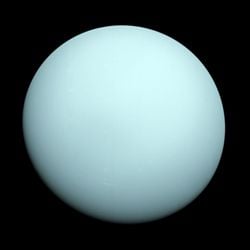Uranus: Difference between revisions
From Halopedia, the Halo wiki
m (Text replacement - "<references/>" to "{{Ref/Sources}}") |
m (Text replacement - "<ref name="([^"=>]+)" ?\/>" to "{{Ref/Reuse|$1}}") |
||
| Line 23: | Line 23: | ||
'''Uranus''', named after the Roman personification of the sky, is the [[Seven|seventh]] planet in the [[Sol system]].<ref name="Encyclopedia">''[[Halo Encyclopedia: The Definitive Guide to the Halo Universe]]'', page. 294-295, 2011 edition</ref> | '''Uranus''', named after the Roman personification of the sky, is the [[Seven|seventh]] planet in the [[Sol system]].<ref name="Encyclopedia">''[[Halo Encyclopedia: The Definitive Guide to the Halo Universe]]'', page. 294-295, 2011 edition</ref> | ||
An oddity among Sol's gas giants, Uranus is mostly unexplored and uninhabited by [[humanity]], as its distance from [[Sol]] makes traveling there costly. Its moons are poorly-understood when compared to those of [[Jupiter]]. Despite this, Uranus has a number of distinctive features that separate it from its neighbors. Firstly, its axial tilt has turned its poles past a 90<sup>o</sup> angle to the orbital plane. Secondly, Uranus has a number of anomalous radiation spikes that have not been addressed or explained. | An oddity among Sol's gas giants, Uranus is mostly unexplored and uninhabited by [[humanity]], as its distance from [[Sol]] makes traveling there costly. Its moons are poorly-understood when compared to those of [[Jupiter]]. Despite this, Uranus has a number of distinctive features that separate it from its neighbors. Firstly, its axial tilt has turned its poles past a 90<sup>o</sup> angle to the orbital plane. Secondly, Uranus has a number of anomalous radiation spikes that have not been addressed or explained. {{Ref/Reuse|Encyclopedia}} | ||
== Sources == | == Sources == | ||
Revision as of 12:44, April 15, 2021
| There is more information available on this subject at Uranus on the English Wikipedia. |
Uranus, named after the Roman personification of the sky, is the seventh planet in the Sol system.[1]
An oddity among Sol's gas giants, Uranus is mostly unexplored and uninhabited by humanity, as its distance from Sol makes traveling there costly. Its moons are poorly-understood when compared to those of Jupiter. Despite this, Uranus has a number of distinctive features that separate it from its neighbors. Firstly, its axial tilt has turned its poles past a 90o angle to the orbital plane. Secondly, Uranus has a number of anomalous radiation spikes that have not been addressed or explained. [1]
Sources
- ^ a b Halo Encyclopedia: The Definitive Guide to the Halo Universe, page. 294-295, 2011 edition
| ||||||||
